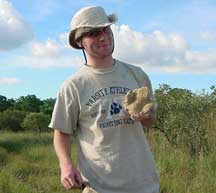 |






|
 |

 |
 |
 |
 |

A tapir track found near one of our sites. Track pictures are taken with a reference object so the size can be compared accurately. |
 |
 |
 |
Track Traps Continued
Phil
For the past two days I have been going out to work on the Hudson High track trap project. We started this project from scratch using some ideas from Hudson High teachers Mr. Gilliatt and Mr. Vacchina (known by us as P-Vac) and techniques we learned form Natalie. Natalie was at the fazenda with the small mammals group. She was evaluating a new method of collecting trap imprints that she hopes will work better in the rain; and be more convenient than the more traditional sand-sifting model. (We told you more details about her project several days ago. See the "Track Traps" field report from 2/21/03).
We ended up setting seven traps in all, each with their own individual characteristics and potential problems that we had to deal with and solve. For example, our first trap was in an extremely moist area. We placed it right at the edge of the Salina de Paula and found the tracks to be too distorted from the soft mud. First, we implemented a masonry technique, flattening the entire area with a plastic sheet (it was actually the cover of Melissa's notebook), to make the surface firmer. Also, we had limited bait during that first day so we ended up using two fruits, gravatura (the fruits of the aloe-lie plant with spiky leaves) and a peccary favorite — the acuri (a palm fruit loved by most frugivores). We needed something to attract predators like puma and jaguar. Natalie used a lure of bobcat urine to entice such animals to investigate the foreign scent.
Since I did not have the same resources with me, we decided to try a human scent. Being as hot as it was we were sweating profusely, so we took advantage of the situation and rubbed our sweat on a stick. Although the idea of rubbing your body against a stick would seem useless, we must remember the senses of the animals we are dealing with are much more sensitive than our own. Most would characterize our attempts as futile, but I believe it displays our creativity and resourcefulness in the field.
 |
 |
 |

Phil proudly displays a beautiful mold made from a beautiful track! |
 |
 |
 |
We checked all the experiments the following day and were rewarded with a diversity of interesting prints at many of the sites. Including a young puma at the site with our human scent. We checked the traps in the morning and in the afternoon, recording the number and diversity of tracks collected, the general condition of the site, what we used for new bait, and whether we reset the trap or left it as it was. We also took casts of any good prints to establish a working collection of traps to bring back to school. In the evening I took the data and developed a spreadsheet where we will gather our ongoing data, and a recording sheet for the next group to further improve on our methods and build on our initial ideas.
For more information, click on the Hudson School site.
Photos
courtesy of Earthwatch Institute
|
 |
 |
|
|
|
 |

